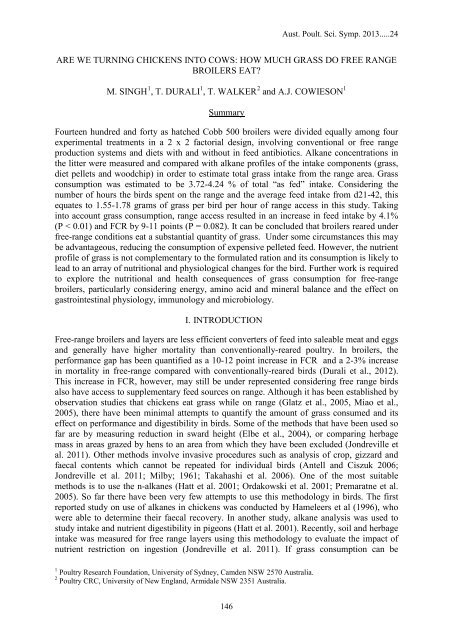APSS 2013 Proceedings - The University of Sydney
APSS 2013 Proceedings - The University of Sydney
APSS 2013 Proceedings - The University of Sydney
You also want an ePaper? Increase the reach of your titles
YUMPU automatically turns print PDFs into web optimized ePapers that Google loves.
Aust. Poult. Sci. Symp. <strong>2013</strong>.....24<br />
ARE WE TURNING CHICKENS INTO COWS: HOW MUCH GRASS DO FREE RANGE<br />
BROILERS EAT?<br />
M. SINGH 1 , T. DURALI 1 , T. WALKER 2 and A.J. COWIESON 1<br />
Summary<br />
Fourteen hundred and forty as hatched Cobb 500 broilers were divided equally among four<br />
experimental treatments in a 2 x 2 factorial design, involving conventional or free range<br />
production systems and diets with and without in feed antibiotics. Alkane concentrations in<br />
the litter were measured and compared with alkane pr<strong>of</strong>iles <strong>of</strong> the intake components (grass,<br />
diet pellets and woodchip) in order to estimate total grass intake from the range area. Grass<br />
consumption was estimated to be 3.72-4.24 % <strong>of</strong> total “as fed” intake. Considering the<br />
number <strong>of</strong> hours the birds spent on the range and the average feed intake from d21-42, this<br />
equates to 1.55-1.78 grams <strong>of</strong> grass per bird per hour <strong>of</strong> range access in this study. Taking<br />
into account grass consumption, range access resulted in an increase in feed intake by 4.1%<br />
(P < 0.01) and FCR by 9-11 points (P = 0.082). It can be concluded that broilers reared under<br />
free-range conditions eat a substantial quantity <strong>of</strong> grass. Under some circumstances this may<br />
be advantageous, reducing the consumption <strong>of</strong> expensive pelleted feed. However, the nutrient<br />
pr<strong>of</strong>ile <strong>of</strong> grass is not complementary to the formulated ration and its consumption is likely to<br />
lead to an array <strong>of</strong> nutritional and physiological changes for the bird. Further work is required<br />
to explore the nutritional and health consequences <strong>of</strong> grass consumption for free-range<br />
broilers, particularly considering energy, amino acid and mineral balance and the effect on<br />
gastrointestinal physiology, immunology and microbiology.<br />
I. INTRODUCTION<br />
Free-range broilers and layers are less efficient converters <strong>of</strong> feed into saleable meat and eggs<br />
and generally have higher mortality than conventionally-reared poultry. In broilers, the<br />
performance gap has been quantified as a 10-12 point increase in FCR and a 2-3% increase<br />
in mortality in free-range compared with conventionally-reared birds (Durali et al., 2012).<br />
This increase in FCR, however, may still be under represented considering free range birds<br />
also have access to supplementary feed sources on range. Although it has been established by<br />
observation studies that chickens eat grass while on range (Glatz et al., 2005, Miao et al.,<br />
2005), there have been minimal attempts to quantify the amount <strong>of</strong> grass consumed and its<br />
effect on performance and digestibility in birds. Some <strong>of</strong> the methods that have been used so<br />
far are by measuring reduction in sward height (Elbe et al., 2004), or comparing herbage<br />
mass in areas grazed by hens to an area from which they have been excluded (Jondreville et<br />
al. 2011). Other methods involve invasive procedures such as analysis <strong>of</strong> crop, gizzard and<br />
faecal contents which cannot be repeated for individual birds (Antell and Ciszuk 2006;<br />
Jondreville et al. 2011; Milby; 1961; Takahashi et al. 2006). One <strong>of</strong> the most suitable<br />
methods is to use the n-alkanes (Hatt et al. 2001; Ordakowski et al. 2001; Premaratne et al.<br />
2005). So far there have been very few attempts to use this methodology in birds. <strong>The</strong> first<br />
reported study on use <strong>of</strong> alkanes in chickens was conducted by Hameleers et al (1996), who<br />
were able to determine their faecal recovery. In another study, alkane analysis was used to<br />
study intake and nutrient digestibility in pigeons (Hatt et al. 2001). Recently, soil and herbage<br />
intake was measured for free range layers using this methodology to evaluate the impact <strong>of</strong><br />
nutrient restriction on ingestion (Jondreville et al. 2011). If grass consumption can be<br />
1 Poultry Research Foundation, <strong>University</strong> <strong>of</strong> <strong>Sydney</strong>, Camden NSW 2570 Australia.<br />
2 Poultry CRC, <strong>University</strong> <strong>of</strong> New England, Armidale NSW 2351 Australia.<br />
146
















